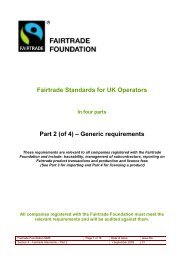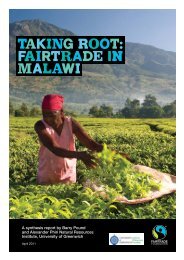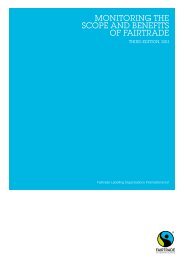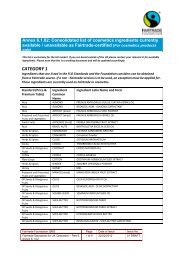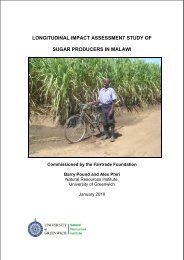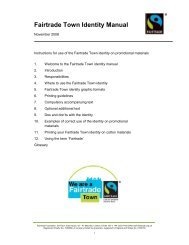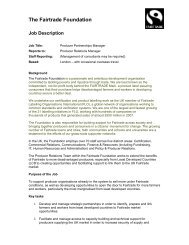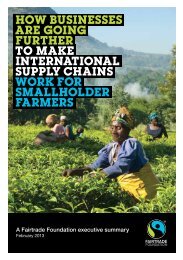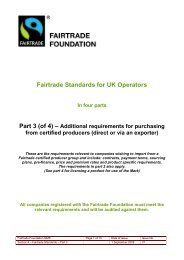the great cotton stitch-Up - The Fairtrade Foundation
the great cotton stitch-Up - The Fairtrade Foundation
the great cotton stitch-Up - The Fairtrade Foundation
You also want an ePaper? Increase the reach of your titles
YUMPU automatically turns print PDFs into web optimized ePapers that Google loves.
External factors, including <strong>the</strong> recent food price hike<br />
toge<strong>the</strong>r with an increase in <strong>the</strong> price of <strong>the</strong> inputs<br />
needed to cultivate <strong>cotton</strong>, have led many farmers to<br />
switch to producing alternative food crops. <strong>The</strong>se are<br />
not necessarily more profitable but can ensure food<br />
security for farmers’ families.<br />
<strong>The</strong> current relatively high market prices are ensuring<br />
farmers stay cultivating <strong>cotton</strong>, but <strong>the</strong> high prices of<br />
inputs means that many smallholder farmers in Africa<br />
are barely surviving. 7<br />
Subsidies:<br />
Global <strong>cotton</strong> prices are not only dependent on <strong>the</strong><br />
supply and demand of <strong>cotton</strong>. <strong>The</strong>y also depend<br />
on <strong>the</strong> level of subsidies available to producers and<br />
exporters in o<strong>the</strong>r nations. With a guaranteed price,<br />
production decisions are not entirely market driven.<br />
Subsidies lead to higher levels of production that<br />
demand and supply would naturally determine in a<br />
free market. <strong>The</strong> world price slumps when <strong>the</strong> supply<br />
of <strong>cotton</strong> is artificially increased in this way.<br />
Burkina Faso, for instance, incurred losses of $27m<br />
in potential revenue in 2002 because of depressed<br />
prices of agricultural products – roughly <strong>the</strong> same<br />
amount it saved in debt repayments under <strong>the</strong> World<br />
Bank’s Heavily Indebted Poor Countries initiative, a<br />
programme to reduce poor countries’ debts.<br />
While no data exist to measure <strong>the</strong> impact of trade<br />
distorting subsidies at a national level, recent World<br />
Bank studies have projected that falls in <strong>cotton</strong> prices<br />
of between 20% and 40% could lead to increases in<br />
overall rural poverty of 3.4% – 4.6%, and even higher<br />
increases among <strong>cotton</strong> farming households.<br />
Mali fact file<br />
Population (2008)<br />
12,710,000<br />
Enrolment<br />
in education<br />
46.9%<br />
(37.5% female,<br />
51% male)<br />
$$ $$$$$<br />
GDP<br />
14 <strong>The</strong> <strong>great</strong> <strong>cotton</strong> <strong>stitch</strong>-up<br />
73.8 %<br />
Adult<br />
illiteracy<br />
rate<br />
(over 15)<br />
Children<br />
underweight<br />
for age<br />
(under 5)<br />
33%<br />
per capita<br />
If subsidies were eliminated, production would decline<br />
in countries that subsidise <strong>cotton</strong>, but would rapidly<br />
expand in o<strong>the</strong>r countries in response to higher<br />
prices. As a result production would shift toward<br />
lower-cost producing countries.<br />
<strong>The</strong> International Cotton Advisory Committee (ICAC)<br />
says subsidies reduce prices by 10%; <strong>the</strong> World Bank<br />
says 12.9%, amounting to an annual revenue loss to<br />
African producers of $147m. Oxfam calculates that<br />
removing US <strong>cotton</strong> subsidies alone would increase<br />
world prices by 6-14%, producer prices in West Africa<br />
by 5-12%, and average household income in West<br />
Africa by 2-9% – enough to support food expenditure<br />
for a million people.<br />
Higher prices in Mali lead to<br />
investment in education<br />
<strong>The</strong> impact of increased incomes through higher<br />
prices can in part be seen by what farmers invest<br />
in if <strong>the</strong>y receive a higher price. For example,<br />
producers who have sold <strong>cotton</strong> on <strong>Fairtrade</strong><br />
terms often talk about education. In Mali, in <strong>the</strong><br />
Kita district, one of <strong>the</strong> first projects resulting from<br />
boosted income was <strong>the</strong> construction of a block<br />
of two classrooms.<br />
ICAC notes, ‘Some female family members –<br />
particularly those involved in premium-paying<br />
niche market value chains such as <strong>Fairtrade</strong> and<br />
organic – report increased independence and<br />
status in family decision-making, as a result of<br />
<strong>the</strong>ir work on an export crop such as <strong>cotton</strong>.’ 8<br />
$$<br />
1083 77.1%<br />
(PPP US$)<br />
HDI Ranking<br />
out of 182:<br />
178th<br />
LOW<br />
HUMAN<br />
DEVELOPMENT<br />
Population living<br />
below $2 a day<br />
Source: Data from <strong>the</strong> United Nations Development Programme, ‘Human Development Report 2009’ and World Bank 2009<br />
Child mortality rate<br />
(under 5)<br />
per 1000: 194<br />
Life expectancy<br />
at birth (years):<br />
48.1<br />
Agriculture<br />
as % of GDP<br />
37%<br />
A water bore hole paid with <strong>Fairtrade</strong> premiums in Diadoubala, Mali<br />
‘If subsidies<br />
were eliminated,<br />
production would<br />
decline in countries<br />
that subsidise<br />
but would rapidly<br />
expand in o<strong>the</strong>rs,<br />
in response to<br />
higher prices.’



